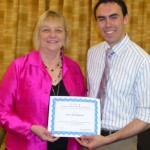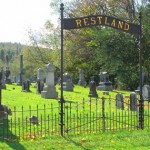While I was busy being “Lady in Distress” with a toddler-dragon wielding a play-kitchen frying pan, Ancestry.com announced that it would discontinue development and support of it’s stand-alone genealogy database software, FamilyTree Maker. By the time I was rescued by Sir David and retreated to my turret to check the news, over 5,200 petitions and protests had been logged in to the comment area of the Ancestry.com blog post. Clearly, the realm was in flames.
“The Sky is Falling, The Sky is Falling” — Chicken Little
The rhetoric on these posts range from fury to meek acceptance, from despair to damning. The only reaction that seems to be missing is regret for not having a backup for the database software.
You Do Have a Backup, Right?
We’ve all heard the drill about Backup 3-2-1. Three copies, two media, one offsite. So we backup our genealogy research notes and database files to the Cloud, to external hard drives, and DVDs. But how many of us have an alternate, or backup, for our genealogy software?
If we lose MS Word or another word processor, we could use Scrivener, Notepad, or a pen and pencil. Sometimes I use a calculator and ledger pad instead of Excel.
Proprietary software is not forever. I purchase a license to use the program. I am not a shareholder invested in the viability of the company. All I get for my $40 is permission to use the tool.
Software is a Tool, Not a Crutch
In my first genealogy course, taught by long-time professional Karen Clifford, I learned that genealogy database software should be regarded as a tool, not a crutch. Karen required each student to keep all research in the Notes section of the genealogy database program (I used Legacy FamilyTree at the time). She didn’t care if we put anything at all in the Facts or Events fields. EVERYTHING had to go into the Notes section. Why?
- Because genealogy software wasn’t “forever” (witness PAF)
- Because we might want to use our data in another program and the Notes had the best chance of transferring through the GEDCOM export/import
- Because it was faster and more efficient to use the Notes field for everything
I admit, I followed the rules for the course, but then slipped back to my Fact and Event entering ways. And when I moved to a Mac and wanted to try out new Mac genealogy software, I had trouble moving all my data through the fussy GEDCOM file. Funny thing, all those Notes made in Karen’s class came through just fine.
So when I did try Reunion for Mac, I had narrative notes, complete with citations, and I could fill in any Facts and Events I wanted to without too much trouble. As a bonus, I could export from Reunion back out to Legacy or RootsMagic to take advantage of their great features like charting and mapping. I could also export to FTM, and sync information so easily downloaded from Ancestry.com.
Not everyone wants to bother with moving their data around between programs, but I am so grateful that Karen insisted her students learn to create a GEDCOM and get comfortable with using them. And I am so glad I still have my data in the Notes sections.
Today I use Reunion for Mac as my Master Database. My research is transcribed, extracted and analyzed directly in the Notes section forming a running, chronological report as I work. It’s easy to pick up again after a break. I don’t lose information. I often enter key events and dates as events to take advantage of Timeline features, especially those available in other programs.
I resisted the Note-centric research method with vigor, but relented when I saw the benefits beginning to tilt the scale:
- Notes gave me a place to record analysis, comments, notes for further study.
- Notes gave me a place to record stories.
- Notes could easily grow into ancestor sketches
I liked the ease and convenience offered by FamilyTree Maker in locating information at Ancestry.com and downloading it to my own desktop database. It was still a lot of work to sort the wheat from the chaff and to keep track of “Private” vs “Public” data and trees, but TreeSync was a useful feature.
This Might be “A Good Thing”
All genealogists stand to benefit from Ancestry’s move to support an online-only tree experience. The funds and resources expended on maintaining and developing FTM can be used to focus on one platform, not two. We may see new innovations and improved features. Desktop software companies like RootsMagic and Legacy will grow their user-base, and this helps to enrich their programs. Win-Win.
FamilyTree Maker users will be able to use the software throughout 2016, and these transition months would be a good time to think about a backup plan for your genealogy database. Experienced leaders like Russ Worthington and DearMyrt will certainly offer helpful support and suggestions for viable alternatives. Legacy and RootsMagic are already extending ideas for migrating. If you’re a Mac user, this might be a good time to check out Reunion for Mac and MacFamily Tree.
Try more than one program. Learn to create and use a GEDCOM. Promise yourself that you will become database-diverse so you can continue to do what you enjoy. And get a backup plan in place.
As Sir David says, “It’s okay. You’ll be okay.”
Photo: US AirForce






